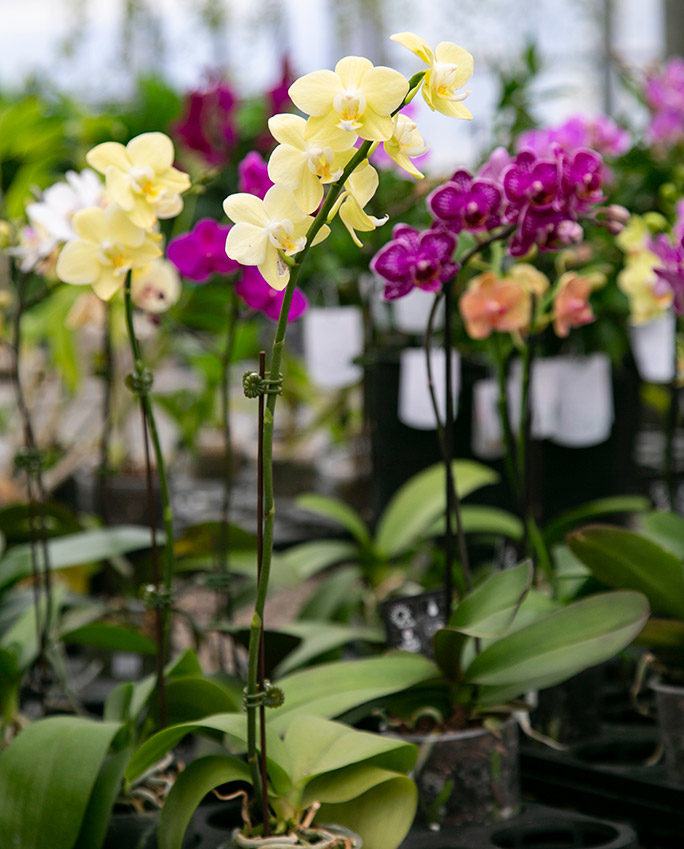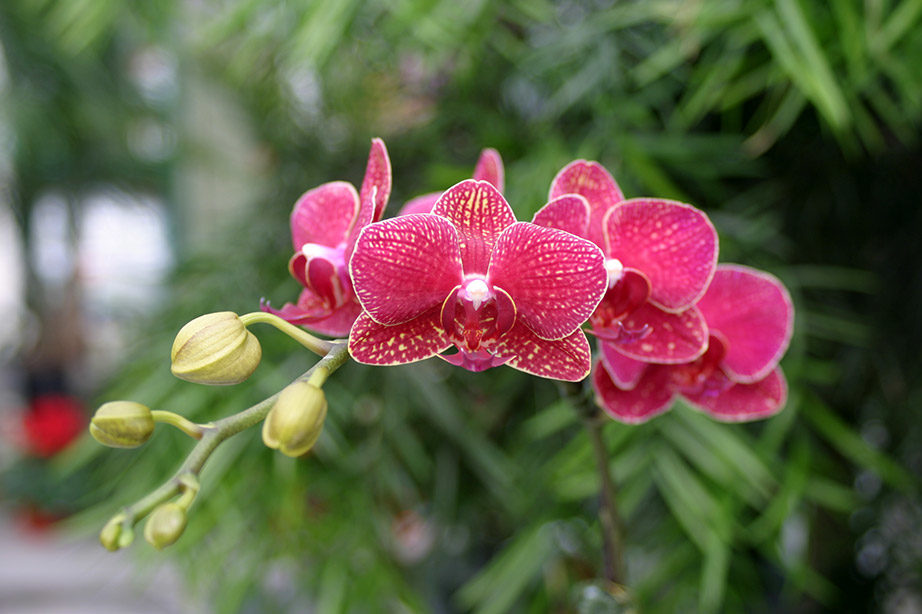HOUSEPLANTS
ORCHIDS
Often referred to as “Phals”, Phalaenopsis are the most recognizable of the Orchid genus. They are easily grown in the home, and with a few basic care requirements, they can reward you by flowering a few times a year.
Light
Phalaenopsis thrive best in bright, indirect light, meaning they should be able to see as much of the sky as possible without seeing the sun. This is typically a space within 2-3 feet of a large window and direct sunlight can cause burning on the leaves of the plant. If the leaves are a nice, solid green it is receiving appropriate light, but if the leaves are slightly reddish, then the light exposure is too high.
Water
Watering an orchid can be a little different than other plants in your home as they are considered epiphytes, meaning they absorb their nutrients from the air and water, rather than soil. The frequency of watering depends on the plant’s location, the size and type of pot, the type of growing medium it is in, and will even vary from season to season as the light fluctuates. Make sure you wait until the growing medium is almost entirely dry in between watering.
When it’s time to water, you can either water from the top or from the bottom. For top-watering, make sure you water directly on the growing media and avoid getting moisture on the leaves to prevent rot. For bottom-watering, immerse the pot up to the rim for approximately a minute, then allow it to drain thoroughly before placing it back in its home.

While over-watering is far more common and destructive, underwatering resulting in long periods of drought will dehydrate the roots to the point that they are unable to uptake any more water and can cause death of the plant as well. Both of these situations are easily avoidable with regular monitoring of the roots and growing medium so don’t let the fear of a mistake stop you from enjoying these beautiful blooms!
The quality of the water is also very important! Orchids are heavily affected by mineral deposits so be sure to use chlorine-free or non-softened water. Alternatively, once a month, you can use clear (unfertilized) water to “flush” your plant to clear any accumulated salts or minerals from the potting mix. To do this, the plant must be in a pot with drainage holes. Just sit the plant under a tap for a minute or two and allow water to run through the pot and drain into the sink. Room temperature water is ideal as cold or hot water can affect the long-term health of the roots.
Humidity
Phals thrive best in temperatures between 20-24°C and strongly dislike cold drafts. Be cautious about any drafty windows and opening doors in the winter. Avoid placing them near any vents, radiators or any other heat sources as well as this will cause the growing medium and roots to dry out too quickly. Humidifiers to increase humidity levels can benefit Phals but are by no means necessary.
Growing Mediums & Repotting
It is best to repot your Phal into fresh orchid media once a year (not regular potting soil), preferably right after the flowers expire or right after the plant starts to put out any new growth. Phaleonopsis prefer to be fairly “tight” or root-bound in their pot so most of the time it is best to repot into the same container with fresh media.
When it is time to move up into a bigger pot size (typically every 3 to 4 years), pick one that is only slightly larger than the previous one (1-2”). Just remember, orchids naturally have aerial roots (roots that sit up out of the pot and not in the growing medium) so make sure to leave any existing roots exposed when you repot.
The other feature that is a little different when it comes to your orchid pots is the colour! Orchids are growing in a clear “orchid pot” in the nursery for a couple reasons - they have more drainage holes allowing for more air to reach the roots and the transparency of the pot allows you to see the colour of the roots to help determine if it needs to be watered or not. It is best to continue to use these types of orchid pots when you are repotting and just place them in something decorative to match your style or decor!
Flowering
Phaleonopsis have a longer blooming period than most, typically lasting between 2 and 6 months from start to finish. Because of the length of their flowering period, Phals can take a while before they bloom again; they need time to recover, develop new leaf and root growth, and collect more energy to produce their next flower. As long as the leaves are still green, your orchid is still alive and will eventually re-bloom so don’t give up on it just because it isn’t flowering!

After your spike (flower) has finished, find the node where the first flower just bloomed and cut just above it - you may get a new spike to emerge from the node in a few months. If the flower stem turns brown, cut it off near the base of the plant where it originated.




